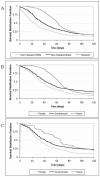Having health insurance does not eliminate race/ethnicity-associated delays in breast cancer diagnosis in the District of Columbia
- PMID: 21815134
- PMCID: PMC4412470
- DOI: 10.1002/cncr.25970
Having health insurance does not eliminate race/ethnicity-associated delays in breast cancer diagnosis in the District of Columbia
Abstract
Background: Delays in follow-up after breast cancer screening contribute to disparities in breast cancer outcomes. The objective of this research was to determine the impact of race/ethnicity and health insurance on diagnostic time, defined as number of days from suspicious finding to diagnostic resolution.
Methods: This retrospective cohort study of 1538 women examined for breast abnormalities between 1998-2010 at 6 hospitals/clinics in the District of Columbia measured mean diagnostic times between non-Hispanic whites (NHWs), non-Hispanic blacks (NHBs), and Hispanics with private, government, or no health insurance by using a full-factorial ANOVA model.
Results: Respective average--geometric mean (95% CI)--diagnostic times (in days) for NHWs, NHBs, and Hispanics were 16 (12, 21), 27 (23, 33), and 51 (35, 76) among privately insured; 12 (7, 19), 39 (32, 48), and 71 (48, 105) among government insured; 45 (17, 120), 60 (39, 92), and 67 (56, 79) among uninsured. Government insured NHWs had significantly shorter diagnostic times than government insured NHBs (P = .0003) and Hispanics (P < .0001). Privately insured NHWs had significantly shorter diagnostic times than privately insured NHBs (P = .03) and Hispanics (P < .0001). Privately insured NHBs had significantly shorter diagnostic times than uninsured NHBs (P = .03).
Conclusions: Insured minorities waited >2 times longer to reach their diagnostic resolution than insured NHWs. Having private health insurance increased the speed of diagnostic resolution in NHBs; however, their diagnostic time remained significantly longer than for privately insured NHWs. These results suggest diagnostic delays in minorities are more likely caused by other barriers associated with race/ethnicity than by insurance status.
Copyright © 2011 American Cancer Society.
Figures


References
-
- National Cancer Institute (NCI) State Cancer Profiles. National Cancer Institute (NCI) National Institutes of Health (NIH) U.S. Department of Health and Human Services (USDHHS); [accessed Jan. 14, 2010]. 2009. in conjunction with the Centers for Disease Control and Prevention. Available at: http://statecancerprofiles.cancer.gov.
-
- Kaiser Family Foundation. D.C. Health Care Access Survey, Race, Ethnicity, and Health Care, Issue Brief. Kaiser Family Foundation. [accessed Jan. 2010]. Oct, 2003. Publication #6108. Available at: http://www.kff.org/minorityhealth/upload/D-C-Health-Care-Access-Survey-2....
-
- Lurie N, Gresenz CR, Blanchard JC, Ruder T, Chandra A, Ghosh-Dastidar B, Price A. Assessing Health and Health Care in the District of Columbia: Working Paper, Rand Health, Prepared for the Executive Office of the Mayor, District of Columbia. [accessed Jan. 14, 2010]. Jan, 2008. Available at: http://www.rand.org/pubs/working_papers/2008/RAND_WR534.pdf.
-
- Patierno SR, LaVerda NL, Alexander LM, Levine PH, Young HA, Hoffman HJ. Longitudinal Network Patient Navigation: Development of a city-wide integrative model to reduce breast cancer disparities in Washington, DC. Oncology Issues. 2010;25:28–35.
-
- Centers for Disease Control and Prevention National Breast and Cervical Cancer Early Detection Program (NBCCEDP), NBCCEDP Program Manual. [accessed August 22, 2010]. Available at: http://www.cancerutah.org/Healthcare_Provider/UCCP_policies/P&P_PDFs/NBC....
Publication types
MeSH terms
Grants and funding
LinkOut - more resources
Full Text Sources
Medical

